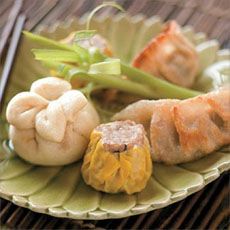TIP OF THE DAY: Dim Sum At Home
|
We live in a city with a large Chinatown—lots of places to enjoy dim sum. But even if you’re many miles from the nearest restaurant, you can make delicious dim sum at home. Not frozen dim sum but your own homemade treats, but ones made with your own flour, ground meat, seafood and veggies. It may look complex, but most dishes are quite simple to make. Just check out this easy dim sum cookbook. There are also many recipes and videos online. Many Americans think of dim sum, a Cantonese tradition, as weekend brunch. But it can be enjoyed every day, for every meal. There are tempting options for every palate, from vegetarian and vegan to meat and seafood. Some of our favorites: |
||
|
|
||
 A true pleasure: your own homemade shumai (pork dumplings, pronounced shoo-MY). Photo courtesy Ramar Foods. |
PARTY TIME Dim sum can be served for brunch/lunch and as cocktail party fare. If the idea of preparing dim sum is intimidating, plan a co-op party with friends who like to cook. Everyone can make one or two dishes. A dim sum party is an opportunity to sample a few different teas as well. Take a look at chrysanthemum, dragon well, jasmine, gunpowder, keemum, lychee, oolong, pu-erh—brewed from whole leaf tea, of course! (Check out the different types of tea.) |
|
|
DIM SUM HISTORY Dim sum derives from an older tea house tradition, yum cha (tea tasting), in the Canton province southern China. Travelers would take refreshment at roadside teahouses; locals would stop by to relax after a day of tilling the fields or other labor. At some point teahouse owners began to add snacks: hence the development of dim sum. The translation of dim sum, “touches the heart,” shows that it was originally not a main meal but a snack. Over the centuries, dim sum evolved from an afternoon respite to a major meal, from breakfast through mid-afternoon. Some modern restaurants extend dim sum to dinner time; it is now a staple of Cantonese dining culture and served all over China. For a dim sum holiday head to Hong Kong, the dim sum capital of the world. If you’re in a major U.S. city, head to its Chinatown. In New York City, our favorite is Jing Fong, a huge restaurant with the largest selection we’ve ever seen. The food is wheeled around on carts by servers; you point to what you want. Food is priced by the dish, but you can gorge yourself for not much more than $15-$20 a person. To end the confusion of what’s what, you can get this dim sum pocket guide, in paperback or Kindle editions. Sihk faahn (that’s eat, the equivalent of bon appétit, in Cantonese)!
|
||



